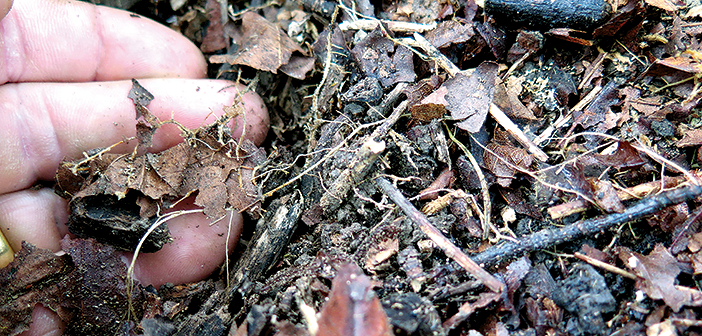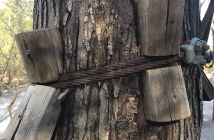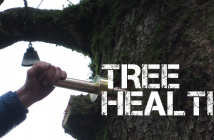ATTACHING STRUCTURES TO TREES
At present, there are two primary methods for attaching things to trees: using a bolt or other metal fastener inserted into a hole in the tree, or wrapping cables around the tree. There are also several experiments underway that utilize a compression band or compression foot to help minimize negative impacts on trees, which I’ll explore in future articles. For now, let’s consider the two primary methods and how they might affect the trees.
Arborists have long studied what happens when a hole is drilled into a tree. In my first article (“Tree Biology and Biomechanics,” August 2015), I mentioned CODIT, Dr. Alex Shigo’s model of decay in trees. Shigo showed that when a tree is wounded or sheds a branch naturally, physiological changes occur that determine how fungal decay will advance within the tree. Once again, the species of tree has great affect on how the CODIT model functions. Simply put, long-lived trees strongly resist the spread of decay while short-lived trees do not. Different tree species have relationships with fungi that decay wood in different ways and at different rates.
When the bark and underlying layers of a tree are damaged, the CODIT response occurs (see below). The spread of decay is slowed by the walls. Wall one slows the spread of the decay up and down the tree. Wall two slows the spread of decay into the tree, toward the center. Wall three slows the spread of decay along the growth rings. Wall four is formed at the time of wounding and comprises the new layers of growth formed after the wound. Wall four is also found between the wood of the branch and the wood of the trunk. Note that branch and trunk wood are distinct parts of a tree’s structure, with different characteristics. Each hole in a tree represents a hole in the vascular system. If too many holes are made in a tree, vascular function may be compromised. This can even happen as the result of pruning; in some species, cutting several branches off in a vertical line could present difficulty repairing that area with new wood, resulting in death of the entire area of cambium.
So let’s be clear: Drilling a hole in a tree to attach a treehouse or course element causes injury to the tree. That said, it’s also a fact that physiologically, trees are pretty good at dealing with holes. When a tree naturally sheds a branch, the wood of the branch deteriorates over time, often leaving an opening. The ability to grow new layers, and in some cases cover the opening, eventually repairing the important cambium layers, is one of the reasons trees can manage holes.
WRAPPED CABLES
Arborists know that wrapping anything around a tree causes problems over time. Many of us have seen people put a piece of hose over a cable that is then wrapped around a tree in an attempt to protect it. This generally doesn’t work, and if no one comes to take the cable away, the tree will envelop it or be girdled by it.
I have observed courses that use cable wrapped around trees and wooden blocks offsetting the cable intended to protect the tree. However, depending on the weight of the cable and the loads transmitted to the tree, it’s likely that the tree will envelop or grow around the blocks. If the force on the blocks is strong enough, it will likely begin to affect the cambium layers behind the bark. And, if moisture gets trapped behind the block, the bark may begin to deteriorate and the surrounding area can die. If, as I see in many cases, a bolt is used to assure the block won’t slip, then the tree has been injured and the CODIT response triggered, negating the reduction of impact intended by wrapping cables instead of bolting a fitting to the tree in the first place.
There are several new inventions that attempt to avoid penetrating a tree with a hole. They use compression points with a ring surrounding the tree trunk to support the structure. The idea is to move the compression points on a regular basis to avoid damaging the trunk. It will be interesting to see the long-term impacts of such systems.
The force needed to cause a tree to begin to envelop an object varies by species, but is known to be up to 150 pounds per square inch. My own observation is that the amount of force varies quite a bit. I have seen situations where blocks have been moved on a regular basis to try and protect a tree. I’m not sure this is working as intended. Where blocks have been left in place, I’ve seen damaged or dead areas beneath them. Arborists have also known for a long time that when small diameter nails or screws are used to attach boards to a tree, there is often a wound response that results in a dead area. There is a need for more understanding here, as many variables are in play.
An example of wrapping that most people will be familiar with would be a young tree staked to the ground when it’s planted. If the stakes and ties are not removed, the ties around the tree will prevent expansion of the new growth layers, cutting off the vascular flow up and down the trunk. The products of photosynthesis cannot get to the roots, and in many cases wood growth above, not below, the strangling ties can be observed before the tree gives up. If the ties don’t strangle the tree but hold it tightly, the tree’s response will be to add material above the tie, where it’s still moving, and reduce growth below, where no reinforcement is needed. Occasionally, a vigorous tree will grow over the ties and the new layers of growth will successfully reconnect the vascular system. However, the ties, now inside the tree, can create a long-term structural defect and the potential to break at this point in the future if a large load is applied.
THE ROOTS
Tree root systems are complex and not well understood by most people. Just as they adapt above ground, trees adapt their root systems to the conditions where they are growing. On their own, without meddling humans, trees are pretty much permanently situated where they first begin to grow.
There are two major types of roots: structural supporting roots and the fine absorbing roots. The structural roots of the tree are the conduit for the water and assimilates that are taken up by the fine roots. They require air and water to survive and grow. This means that porous soil is needed for fine root growth. The fine roots of trees are mostly present within the top foot of the soil. As a result, it is quite easy to disturb a tree’s biological functions by changing the grade, compacting soils, or otherwise altering its rooting area. Roots generally extend out farther than the branches or crown of the tree. In fact, a deciduous tree could have roots extending out from the base up to 2.5 times the height the tree. The roots of coniferous trees can extend to the tree height or beyond, where conditions permit.
In a forest stand, tree roots exist in a fascinating ecosystem along with thousands of other organisms. Many of these are important to the biological success of the trees and companion forest plants. Especially important are the plants in the fungi kingdom.
In urban settings, soils are often dis-turbed and altered by human activity. Turf lawns are an example. Turf soil ecologies are bacterially dominated and somewhat inhospitable to tree roots. Add to this the shallow, water-hungry root mats that turf grasses produce, and it’s clear that trees have serious competition. Many products used to keep lawns green and weed-free end up affecting nearby trees as well.
Now that we have started thinking about the way trees grow, I hope you will seek to expand your knowledge. I am interested in hearing about your own experiences with tree-supported structures, so please feel free to email me. You can expect reports on current research as well as more in-depth information about tree health and how it pertains to the adventure park industry in future columns.






